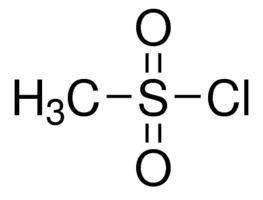Density 1.48 g/cm³ Molar mass 114.56 g/mol Appearance colorless liquid | Formula CH3ClO2S Boiling point 161 °C | |
 | ||
Methanesulfonyl chloride (mesyl chloride) is an organosulfur compound with the formula CH3SO2Cl. It is a colourless liquid that dissolves in polar organic solvents but is reactive toward water, alcohols, and many amines. The simplest organic sulfonyl chloride, it is used to make methanesulfonates and to generate the elusive molecule sulfene.
Contents
Preparation
It is manufactured by the reaction of methane and sulfuryl chloride in a radical reaction:
CH4 + SO2Cl2 → CH3SO2Cl + HClAnother method of manufacture entails chlorination of methanesulfonic acid with thionyl chloride or phosgene:
CH3SO3H + SOCl2 → CH3SO2Cl + SO2 + HClCH3SO3H + COCl2 → CH3SO2Cl + CO2 + HClReactions
Methanesulfonyl chloride is a precursor to many compounds because it is highly reactive. It is an electrophile, functioning as a source of the "CH3SO2+" group.
Methanesulfonates
Methanesulfonyl chloride is mainly used to give methanesulfonates by its reaction with alcohols in the presence of a non-nucleophilic base. Methanesulfonates are used as intermediates in substitution reactions, elimination reactions, reductions, and rearrangement reactions. When treated with a Lewis acid, oxime methanesulfonates undergo facile Beckmann rearrangement.
Methanesulfonates are occasionally used as a protecting group for alcohols. They are stable to acidic conditions and is cleaved back to the alcohol using sodium amalgam.
Methanesulfonamides
Methanesulfonyl chloride react with primary and secondary amines to give methanesulfonamides. Unlike methanesulfonates, methanesulfonamides are very resistant toward hydrolysis under both acidic and basic conditions. When used as a protecting group, they can be converted back to amines using lithium aluminium hydride or a dissolving metal reduction.
Addition to alkynes
In the presence of copper(II) chloride, methanesulfonyl chloride will add across alkynes to form β-chloro sulfones.
Formation of heterocycles
Upon treatment with a base, such as triethylamine, methanesulfonyl chloride will undergo an elimination to form sulfene. Sulfene can undergo cycloadditions to form various heterocycles. α-Hydroxyketones react with sulfene to form five-membered sultones.
Miscellaneous
Forming acyliminium ions from α-hydroxyamides can be done using methanesulfonyl chloride and a base, typically triethylamine.
Safety
Methanesulfonyl chloride is toxic and moisture sensitive, corrosive, and a lachrymator.
